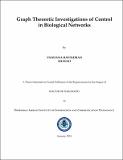Graph theoretic investigations of control in biological networks
Abstract
Biological systems exhibit complex phenomena owing to interconnected molecular mechanisms underlying their architecture. Graph is an ideal mathematical abstraction of such systems. The abstract network along with the dynamics of the system forms a complex network. This thesis focuses on modelling and analysis of biological networks from control systems perspective. We first model the system as a directed network and use the technique of maximum matching to identify driver nodes which help in structurally controlling the system. We investigate the cancer signalling network and propose that identification of specific molecules as drivers of regulatory dynamics is a promising step towards targeted cancer therapies. We also capture the role of driver nodes in the HIV-1-human molecular interactome and show the efficiency with which the virus hijacks the host system for effective pathogenesis. In order to achieve a higher level of understanding of control and its implications in biology, we model five different networks ranging from disease to infection to normal regulation. We find that they are characterized with distributed control and with a large fraction of nodes acting as driver nodes. This implies that such networks are difficult to control. We further investigate the structure of driver nodes in these networks to characterize their control profile. Based on these investigations, we propose that, structural controllability applied to networks can lead to novel understanding of disease mechanisms in a more nuanced way compared to other network analysis. Our work provides a snapshot for control in biological systems assuming that the systems operate under homeostasis. We believe that this approach that amalgamates engineering concepts with biological knowledge can provide better insights into cellular mechanisms of a cell.
Collections
- PhD Theses [87]
Related items
Showing items related by title, author, creator and subject.
-
Comparative study between exponential back off and dynamic waiting strategies for medium access in wireless ad hoc networks
Shah, Rahul (Dhirubhai Ambani Institute of Information and Communication Technology, 2009)IEEE 802.11 DCF (IEEE 802.11 Distributed Coordination Function) is widely used MAC protocol for wireless channel access. Although it is developed for single hop networks where all nodes are in the same radio range, it can ... -
Cache performance evaluation in DSR protocol through cross-layering for mobile ad hoc networks
Sharma, Kapil (Dhirubhai Ambani Institute of Information and Communication Technology, 2009)Wireless mobile ad-hoc networks are being actively studied by many researchers these days. These networks are suitable to be used in various situations because of (i) their infrastructure-less property and (ii) the mobility ... -
Testbed based experimental analysis of transport protocols over wireless ad hoc networks
Shah, Harshil Anilkumar (Dhirubhai Ambani Institute of Information and Communication Technology, 2009)Ad hoc networks are networks with no infrastructure and self-organized in nature. ad hoc networks allow nodes to form network when they come into range of each other provided nodes are configured in ad hoc mode. But these ...

